The Importance of Enterprise Resource Planning Systems Analysis
VerifiedAdded on 2022/12/15
|8
|2099
|99
Report
AI Summary
This report delves into the critical importance of Enterprise Resource Planning (ERP) systems in modern business operations. It highlights how ERP systems facilitate integration across various departments, including product planning, manufacturing, sales, and marketing, consolidating all operations into a single database and user interface. The report explores the benefits of ERP, such as improved efficiency by eliminating duplicate processes, enhanced information integration, easier reporting, improved customer service through data-driven insights, and robust data security. The report also acknowledges the disadvantages, including high implementation costs, rigidity in customization, and lengthy project timelines. Furthermore, the report provides an overview of leading ERP software providers like Oracle NetSuite and Epicor ERP, specifically designed for small and medium-sized enterprises. It concludes by emphasizing the transformative potential of ERP systems in streamlining operations, improving customer service, and enhancing overall business performance.
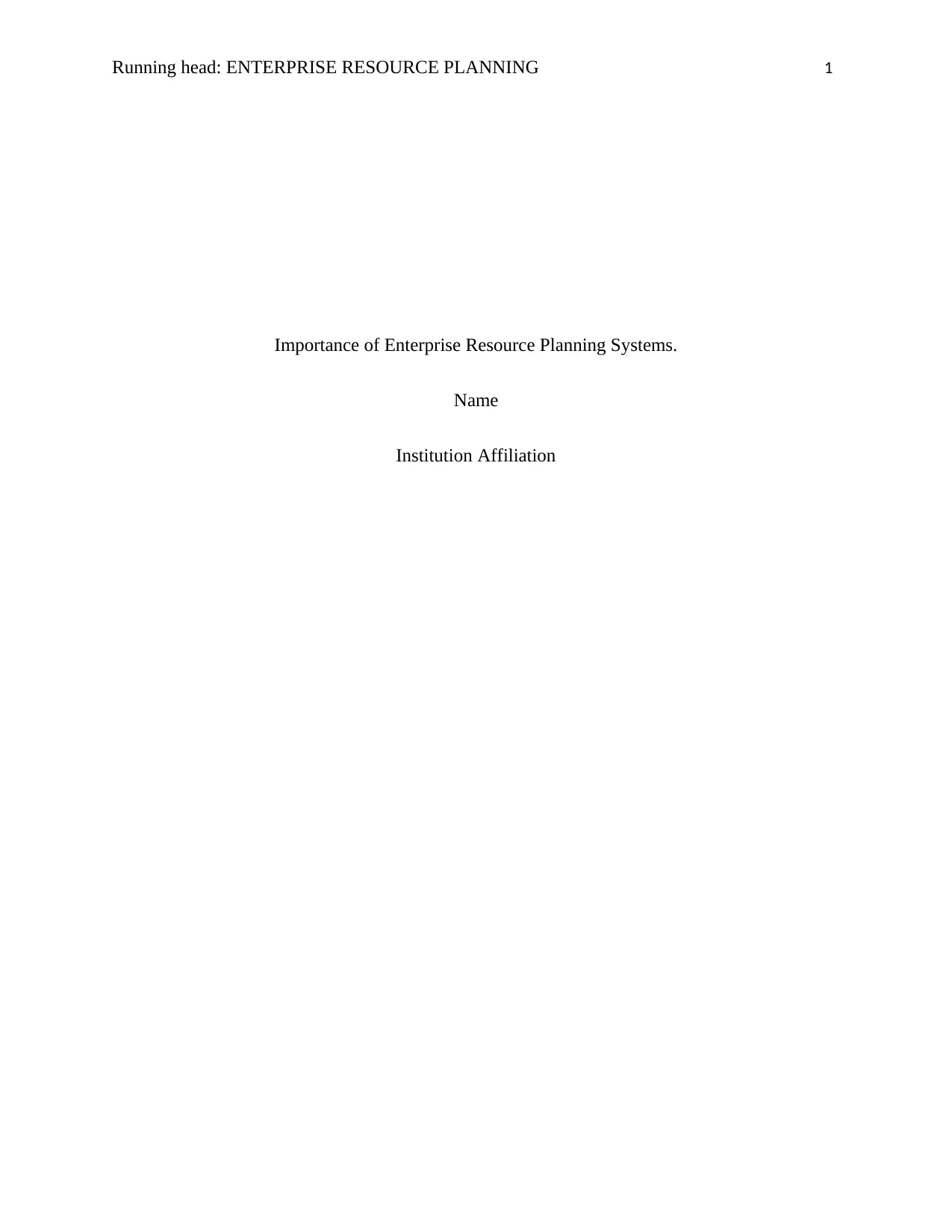
Running head: ENTERPRISE RESOURCE PLANNING 1
Importance of Enterprise Resource Planning Systems.
Name
Institution Affiliation
Importance of Enterprise Resource Planning Systems.
Name
Institution Affiliation
Paraphrase This Document
Need a fresh take? Get an instant paraphrase of this document with our AI Paraphraser
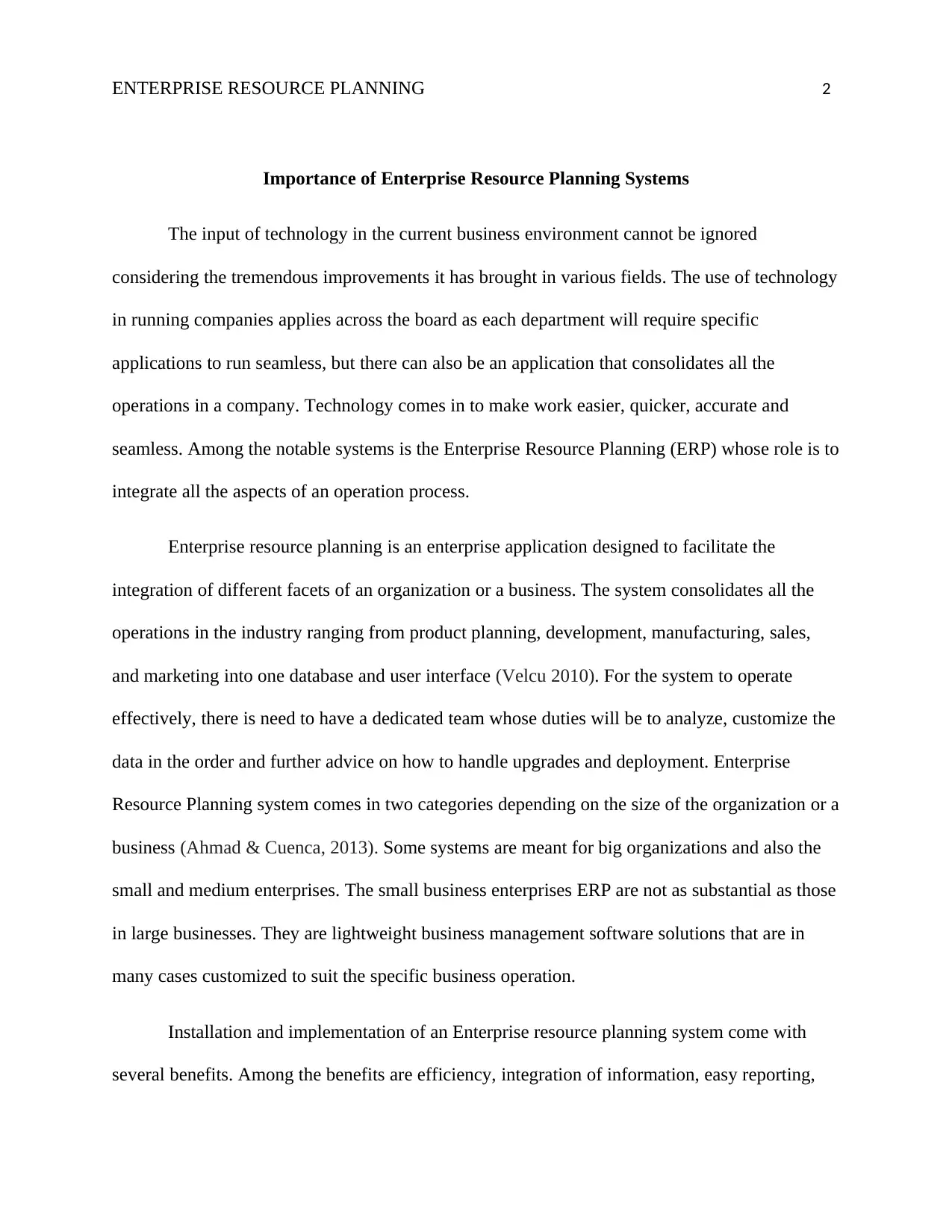
ENTERPRISE RESOURCE PLANNING 2
Importance of Enterprise Resource Planning Systems
The input of technology in the current business environment cannot be ignored
considering the tremendous improvements it has brought in various fields. The use of technology
in running companies applies across the board as each department will require specific
applications to run seamless, but there can also be an application that consolidates all the
operations in a company. Technology comes in to make work easier, quicker, accurate and
seamless. Among the notable systems is the Enterprise Resource Planning (ERP) whose role is to
integrate all the aspects of an operation process.
Enterprise resource planning is an enterprise application designed to facilitate the
integration of different facets of an organization or a business. The system consolidates all the
operations in the industry ranging from product planning, development, manufacturing, sales,
and marketing into one database and user interface (Velcu 2010). For the system to operate
effectively, there is need to have a dedicated team whose duties will be to analyze, customize the
data in the order and further advice on how to handle upgrades and deployment. Enterprise
Resource Planning system comes in two categories depending on the size of the organization or a
business (Ahmad & Cuenca, 2013). Some systems are meant for big organizations and also the
small and medium enterprises. The small business enterprises ERP are not as substantial as those
in large businesses. They are lightweight business management software solutions that are in
many cases customized to suit the specific business operation.
Installation and implementation of an Enterprise resource planning system come with
several benefits. Among the benefits are efficiency, integration of information, easy reporting,
Importance of Enterprise Resource Planning Systems
The input of technology in the current business environment cannot be ignored
considering the tremendous improvements it has brought in various fields. The use of technology
in running companies applies across the board as each department will require specific
applications to run seamless, but there can also be an application that consolidates all the
operations in a company. Technology comes in to make work easier, quicker, accurate and
seamless. Among the notable systems is the Enterprise Resource Planning (ERP) whose role is to
integrate all the aspects of an operation process.
Enterprise resource planning is an enterprise application designed to facilitate the
integration of different facets of an organization or a business. The system consolidates all the
operations in the industry ranging from product planning, development, manufacturing, sales,
and marketing into one database and user interface (Velcu 2010). For the system to operate
effectively, there is need to have a dedicated team whose duties will be to analyze, customize the
data in the order and further advice on how to handle upgrades and deployment. Enterprise
Resource Planning system comes in two categories depending on the size of the organization or a
business (Ahmad & Cuenca, 2013). Some systems are meant for big organizations and also the
small and medium enterprises. The small business enterprises ERP are not as substantial as those
in large businesses. They are lightweight business management software solutions that are in
many cases customized to suit the specific business operation.
Installation and implementation of an Enterprise resource planning system come with
several benefits. Among the benefits are efficiency, integration of information, easy reporting,
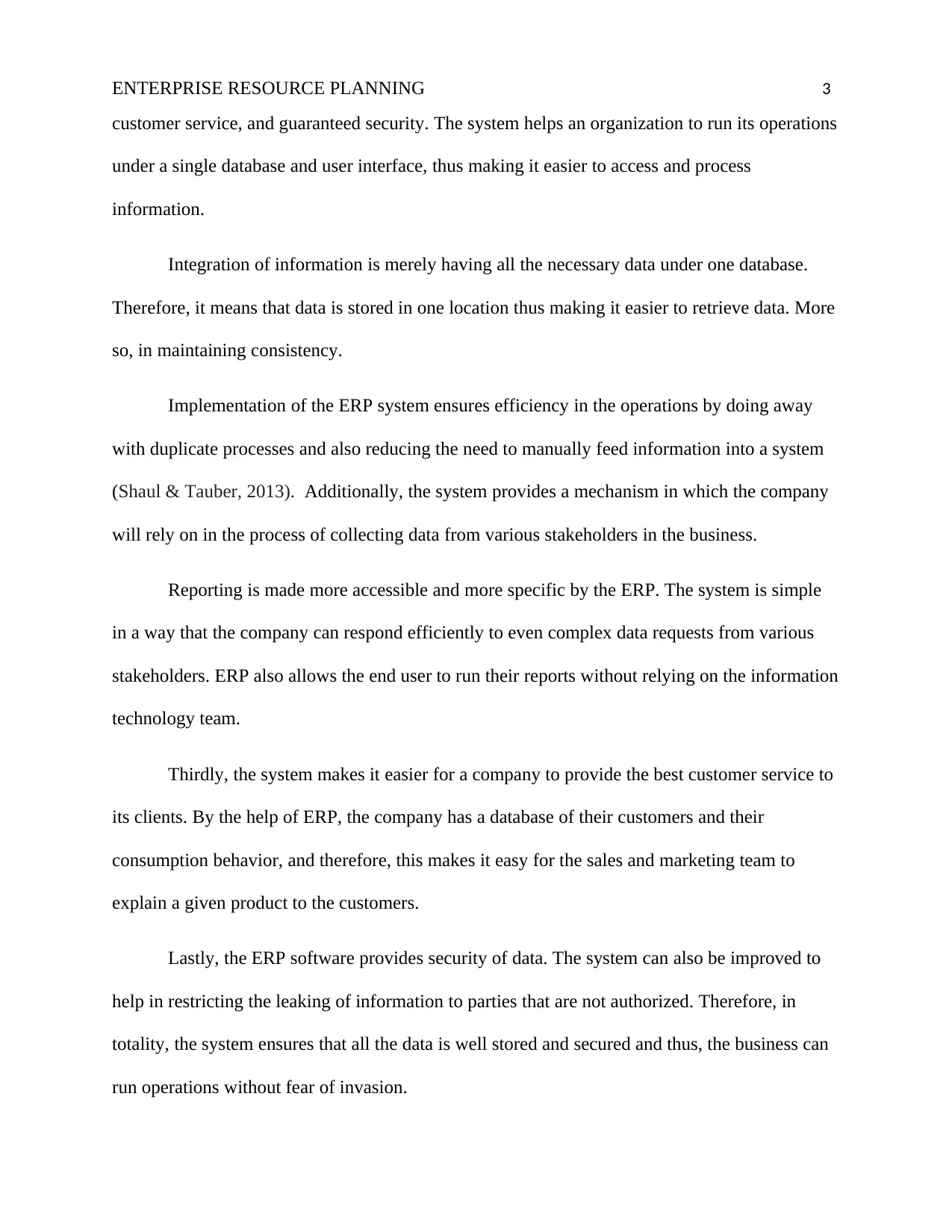
ENTERPRISE RESOURCE PLANNING 3
customer service, and guaranteed security. The system helps an organization to run its operations
under a single database and user interface, thus making it easier to access and process
information.
Integration of information is merely having all the necessary data under one database.
Therefore, it means that data is stored in one location thus making it easier to retrieve data. More
so, in maintaining consistency.
Implementation of the ERP system ensures efficiency in the operations by doing away
with duplicate processes and also reducing the need to manually feed information into a system
(Shaul & Tauber, 2013). Additionally, the system provides a mechanism in which the company
will rely on in the process of collecting data from various stakeholders in the business.
Reporting is made more accessible and more specific by the ERP. The system is simple
in a way that the company can respond efficiently to even complex data requests from various
stakeholders. ERP also allows the end user to run their reports without relying on the information
technology team.
Thirdly, the system makes it easier for a company to provide the best customer service to
its clients. By the help of ERP, the company has a database of their customers and their
consumption behavior, and therefore, this makes it easy for the sales and marketing team to
explain a given product to the customers.
Lastly, the ERP software provides security of data. The system can also be improved to
help in restricting the leaking of information to parties that are not authorized. Therefore, in
totality, the system ensures that all the data is well stored and secured and thus, the business can
run operations without fear of invasion.
customer service, and guaranteed security. The system helps an organization to run its operations
under a single database and user interface, thus making it easier to access and process
information.
Integration of information is merely having all the necessary data under one database.
Therefore, it means that data is stored in one location thus making it easier to retrieve data. More
so, in maintaining consistency.
Implementation of the ERP system ensures efficiency in the operations by doing away
with duplicate processes and also reducing the need to manually feed information into a system
(Shaul & Tauber, 2013). Additionally, the system provides a mechanism in which the company
will rely on in the process of collecting data from various stakeholders in the business.
Reporting is made more accessible and more specific by the ERP. The system is simple
in a way that the company can respond efficiently to even complex data requests from various
stakeholders. ERP also allows the end user to run their reports without relying on the information
technology team.
Thirdly, the system makes it easier for a company to provide the best customer service to
its clients. By the help of ERP, the company has a database of their customers and their
consumption behavior, and therefore, this makes it easy for the sales and marketing team to
explain a given product to the customers.
Lastly, the ERP software provides security of data. The system can also be improved to
help in restricting the leaking of information to parties that are not authorized. Therefore, in
totality, the system ensures that all the data is well stored and secured and thus, the business can
run operations without fear of invasion.
⊘ This is a preview!⊘
Do you want full access?
Subscribe today to unlock all pages.

Trusted by 1+ million students worldwide

ENTERPRISE RESOURCE PLANNING 4
The system, however, has its disadvantages and limitations that make it hard for
businesses to embrace it. First, the system is quite expensive to implement and maintain. The
softwares are costly to acquire and also their operation will need a skilled IT team (Staehr, 2010).
Therefore, the company has to not only to bear the initial cost of acquiring the system and
hardware but also set aside resources to facilitate the training of a team that will be in charge,
customization process, configuration, testing and implementation.
Secondly, the ERP system is a little bit rigid, and this makes it difficult for an
organization or a business to customize the system to fit their specifications. When too much of
customization is done the system tends to slow the projects and therefore making it challenging
to do upgrades (Maguire, Ojiako & Said, 2010). It only allows for a few customization options,
and this stands in the way of fully integrating the ERP to business operations.
Thirdly, projects run under the system is time-consuming even though the results
could be useful. For instance, a project may take between one to three years after deployment for
it to be fully functional. Therefore, it means that the system cannot be used to address short-term
goals but rather long-term.
It is about time that the company need to implement ERP in its operations since it has
grown big with various independent departments. Therefore, the need to adapt the system in
order to help in consolidation of data, improve customer service, increase efficiency and improve
reporting. The system will help the company to cut down on operation cost by streamlining
operations in each department as it will eliminate duplicate roles that may be taking place in
different departments. Additionally, the system will be of great importance to the sales and
marketing team as it will help in the improvement of customer service (Kallunki, Laitinen, &
Silvola 2011). The business being prominent means the number of clients served are also many
The system, however, has its disadvantages and limitations that make it hard for
businesses to embrace it. First, the system is quite expensive to implement and maintain. The
softwares are costly to acquire and also their operation will need a skilled IT team (Staehr, 2010).
Therefore, the company has to not only to bear the initial cost of acquiring the system and
hardware but also set aside resources to facilitate the training of a team that will be in charge,
customization process, configuration, testing and implementation.
Secondly, the ERP system is a little bit rigid, and this makes it difficult for an
organization or a business to customize the system to fit their specifications. When too much of
customization is done the system tends to slow the projects and therefore making it challenging
to do upgrades (Maguire, Ojiako & Said, 2010). It only allows for a few customization options,
and this stands in the way of fully integrating the ERP to business operations.
Thirdly, projects run under the system is time-consuming even though the results
could be useful. For instance, a project may take between one to three years after deployment for
it to be fully functional. Therefore, it means that the system cannot be used to address short-term
goals but rather long-term.
It is about time that the company need to implement ERP in its operations since it has
grown big with various independent departments. Therefore, the need to adapt the system in
order to help in consolidation of data, improve customer service, increase efficiency and improve
reporting. The system will help the company to cut down on operation cost by streamlining
operations in each department as it will eliminate duplicate roles that may be taking place in
different departments. Additionally, the system will be of great importance to the sales and
marketing team as it will help in the improvement of customer service (Kallunki, Laitinen, &
Silvola 2011). The business being prominent means the number of clients served are also many
Paraphrase This Document
Need a fresh take? Get an instant paraphrase of this document with our AI Paraphraser
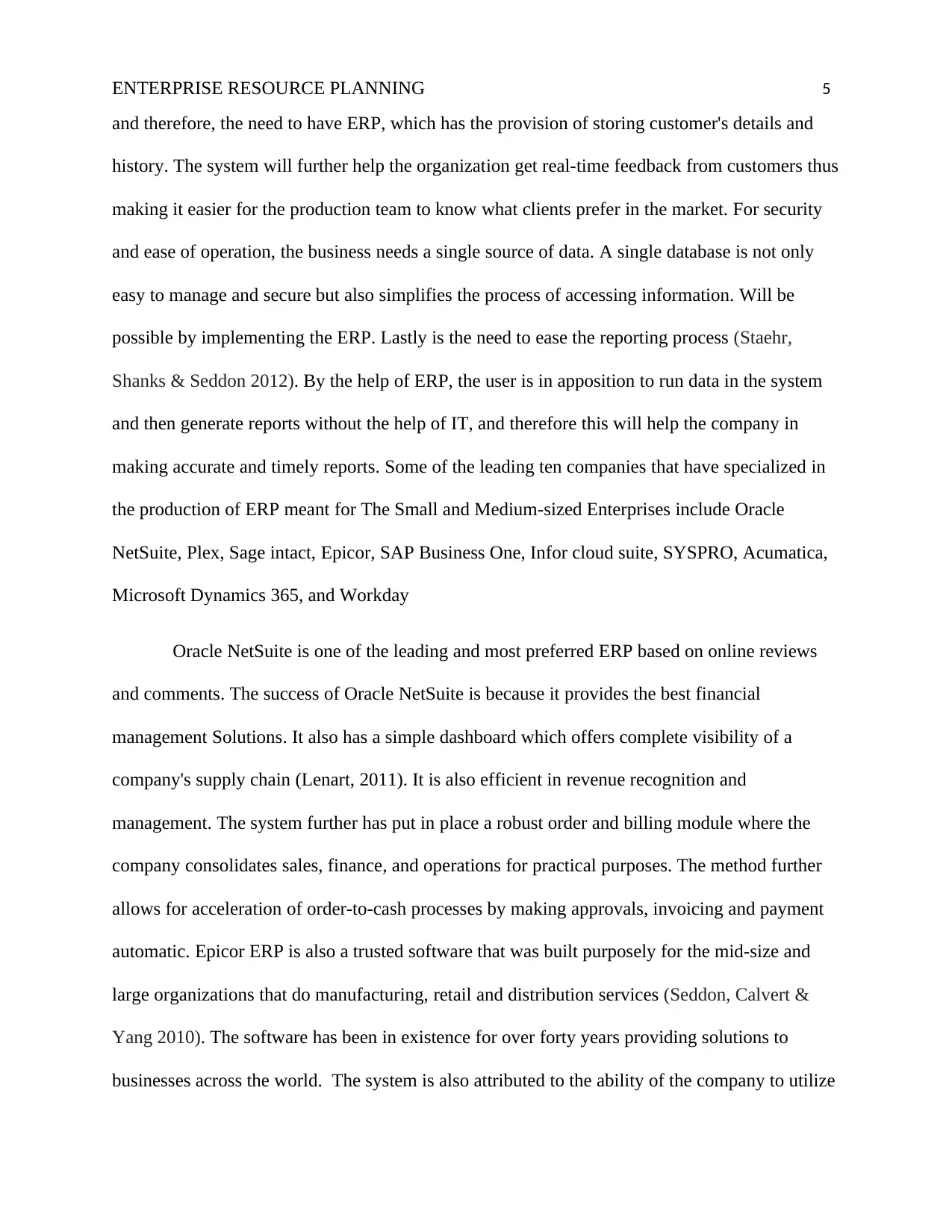
ENTERPRISE RESOURCE PLANNING 5
and therefore, the need to have ERP, which has the provision of storing customer's details and
history. The system will further help the organization get real-time feedback from customers thus
making it easier for the production team to know what clients prefer in the market. For security
and ease of operation, the business needs a single source of data. A single database is not only
easy to manage and secure but also simplifies the process of accessing information. Will be
possible by implementing the ERP. Lastly is the need to ease the reporting process (Staehr,
Shanks & Seddon 2012). By the help of ERP, the user is in apposition to run data in the system
and then generate reports without the help of IT, and therefore this will help the company in
making accurate and timely reports. Some of the leading ten companies that have specialized in
the production of ERP meant for The Small and Medium-sized Enterprises include Oracle
NetSuite, Plex, Sage intact, Epicor, SAP Business One, Infor cloud suite, SYSPRO, Acumatica,
Microsoft Dynamics 365, and Workday
Oracle NetSuite is one of the leading and most preferred ERP based on online reviews
and comments. The success of Oracle NetSuite is because it provides the best financial
management Solutions. It also has a simple dashboard which offers complete visibility of a
company's supply chain (Lenart, 2011). It is also efficient in revenue recognition and
management. The system further has put in place a robust order and billing module where the
company consolidates sales, finance, and operations for practical purposes. The method further
allows for acceleration of order-to-cash processes by making approvals, invoicing and payment
automatic. Epicor ERP is also a trusted software that was built purposely for the mid-size and
large organizations that do manufacturing, retail and distribution services (Seddon, Calvert &
Yang 2010). The software has been in existence for over forty years providing solutions to
businesses across the world. The system is also attributed to the ability of the company to utilize
and therefore, the need to have ERP, which has the provision of storing customer's details and
history. The system will further help the organization get real-time feedback from customers thus
making it easier for the production team to know what clients prefer in the market. For security
and ease of operation, the business needs a single source of data. A single database is not only
easy to manage and secure but also simplifies the process of accessing information. Will be
possible by implementing the ERP. Lastly is the need to ease the reporting process (Staehr,
Shanks & Seddon 2012). By the help of ERP, the user is in apposition to run data in the system
and then generate reports without the help of IT, and therefore this will help the company in
making accurate and timely reports. Some of the leading ten companies that have specialized in
the production of ERP meant for The Small and Medium-sized Enterprises include Oracle
NetSuite, Plex, Sage intact, Epicor, SAP Business One, Infor cloud suite, SYSPRO, Acumatica,
Microsoft Dynamics 365, and Workday
Oracle NetSuite is one of the leading and most preferred ERP based on online reviews
and comments. The success of Oracle NetSuite is because it provides the best financial
management Solutions. It also has a simple dashboard which offers complete visibility of a
company's supply chain (Lenart, 2011). It is also efficient in revenue recognition and
management. The system further has put in place a robust order and billing module where the
company consolidates sales, finance, and operations for practical purposes. The method further
allows for acceleration of order-to-cash processes by making approvals, invoicing and payment
automatic. Epicor ERP is also a trusted software that was built purposely for the mid-size and
large organizations that do manufacturing, retail and distribution services (Seddon, Calvert &
Yang 2010). The software has been in existence for over forty years providing solutions to
businesses across the world. The system is also attributed to the ability of the company to utilize
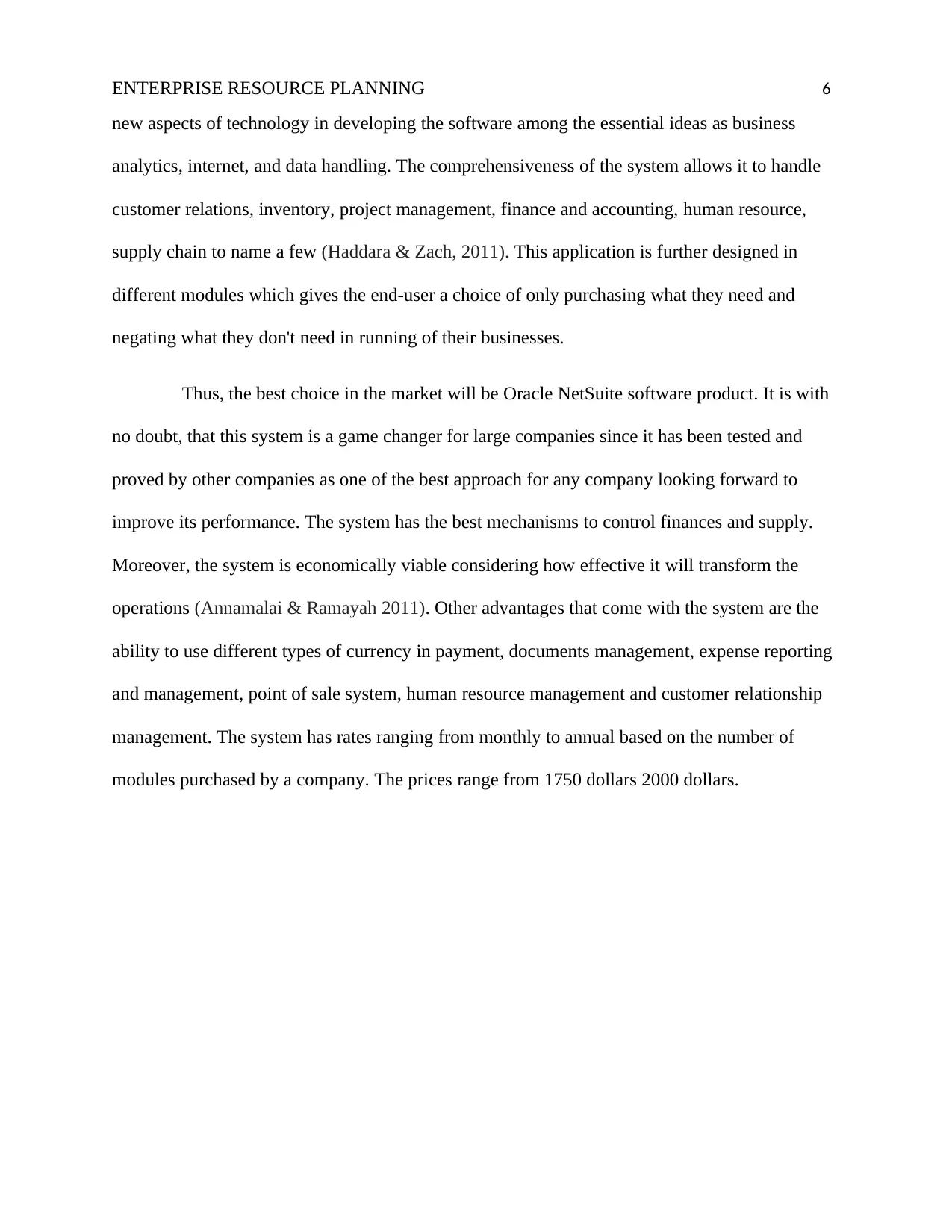
ENTERPRISE RESOURCE PLANNING 6
new aspects of technology in developing the software among the essential ideas as business
analytics, internet, and data handling. The comprehensiveness of the system allows it to handle
customer relations, inventory, project management, finance and accounting, human resource,
supply chain to name a few (Haddara & Zach, 2011). This application is further designed in
different modules which gives the end-user a choice of only purchasing what they need and
negating what they don't need in running of their businesses.
Thus, the best choice in the market will be Oracle NetSuite software product. It is with
no doubt, that this system is a game changer for large companies since it has been tested and
proved by other companies as one of the best approach for any company looking forward to
improve its performance. The system has the best mechanisms to control finances and supply.
Moreover, the system is economically viable considering how effective it will transform the
operations (Annamalai & Ramayah 2011). Other advantages that come with the system are the
ability to use different types of currency in payment, documents management, expense reporting
and management, point of sale system, human resource management and customer relationship
management. The system has rates ranging from monthly to annual based on the number of
modules purchased by a company. The prices range from 1750 dollars 2000 dollars.
new aspects of technology in developing the software among the essential ideas as business
analytics, internet, and data handling. The comprehensiveness of the system allows it to handle
customer relations, inventory, project management, finance and accounting, human resource,
supply chain to name a few (Haddara & Zach, 2011). This application is further designed in
different modules which gives the end-user a choice of only purchasing what they need and
negating what they don't need in running of their businesses.
Thus, the best choice in the market will be Oracle NetSuite software product. It is with
no doubt, that this system is a game changer for large companies since it has been tested and
proved by other companies as one of the best approach for any company looking forward to
improve its performance. The system has the best mechanisms to control finances and supply.
Moreover, the system is economically viable considering how effective it will transform the
operations (Annamalai & Ramayah 2011). Other advantages that come with the system are the
ability to use different types of currency in payment, documents management, expense reporting
and management, point of sale system, human resource management and customer relationship
management. The system has rates ranging from monthly to annual based on the number of
modules purchased by a company. The prices range from 1750 dollars 2000 dollars.
⊘ This is a preview!⊘
Do you want full access?
Subscribe today to unlock all pages.

Trusted by 1+ million students worldwide
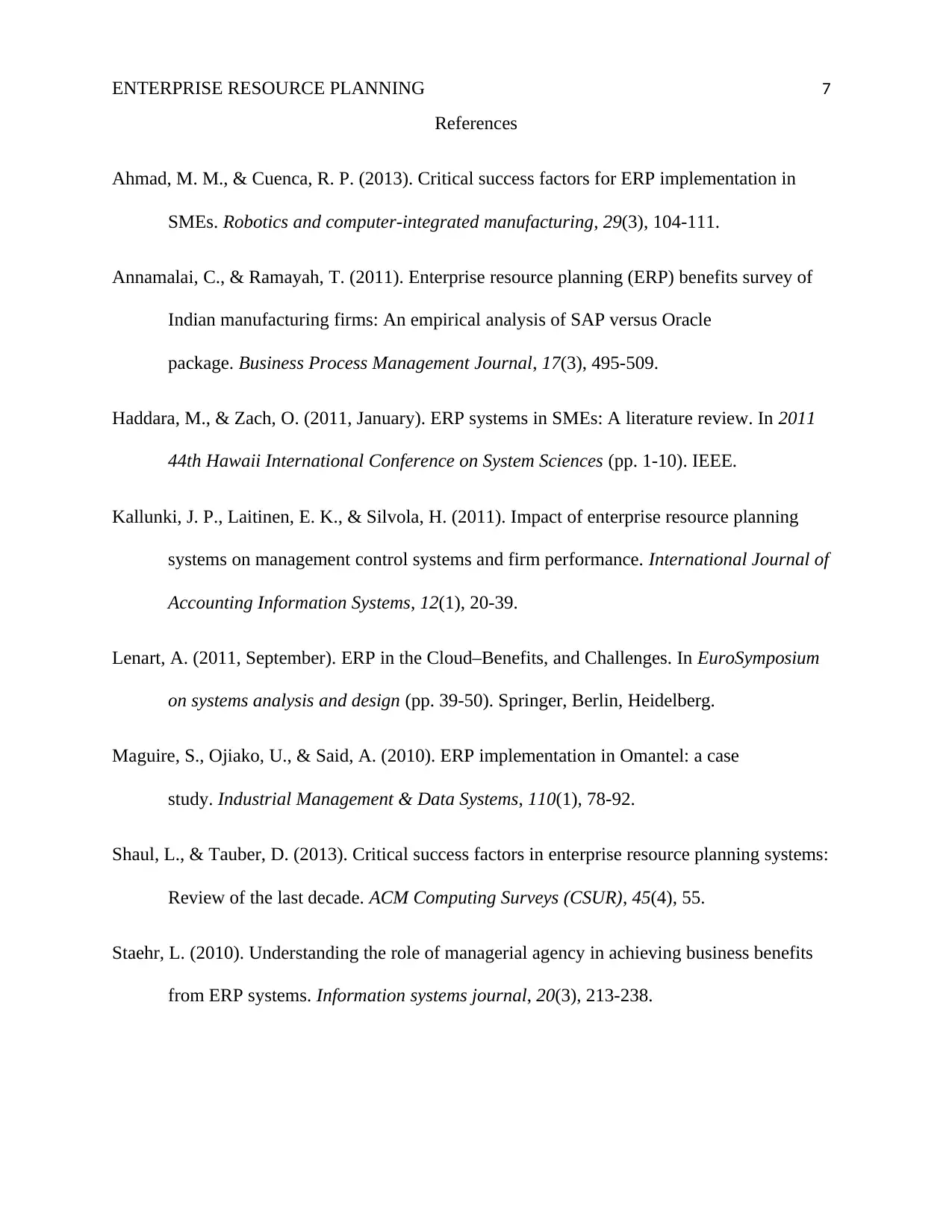
ENTERPRISE RESOURCE PLANNING 7
References
Ahmad, M. M., & Cuenca, R. P. (2013). Critical success factors for ERP implementation in
SMEs. Robotics and computer-integrated manufacturing, 29(3), 104-111.
Annamalai, C., & Ramayah, T. (2011). Enterprise resource planning (ERP) benefits survey of
Indian manufacturing firms: An empirical analysis of SAP versus Oracle
package. Business Process Management Journal, 17(3), 495-509.
Haddara, M., & Zach, O. (2011, January). ERP systems in SMEs: A literature review. In 2011
44th Hawaii International Conference on System Sciences (pp. 1-10). IEEE.
Kallunki, J. P., Laitinen, E. K., & Silvola, H. (2011). Impact of enterprise resource planning
systems on management control systems and firm performance. International Journal of
Accounting Information Systems, 12(1), 20-39.
Lenart, A. (2011, September). ERP in the Cloud–Benefits, and Challenges. In EuroSymposium
on systems analysis and design (pp. 39-50). Springer, Berlin, Heidelberg.
Maguire, S., Ojiako, U., & Said, A. (2010). ERP implementation in Omantel: a case
study. Industrial Management & Data Systems, 110(1), 78-92.
Shaul, L., & Tauber, D. (2013). Critical success factors in enterprise resource planning systems:
Review of the last decade. ACM Computing Surveys (CSUR), 45(4), 55.
Staehr, L. (2010). Understanding the role of managerial agency in achieving business benefits
from ERP systems. Information systems journal, 20(3), 213-238.
References
Ahmad, M. M., & Cuenca, R. P. (2013). Critical success factors for ERP implementation in
SMEs. Robotics and computer-integrated manufacturing, 29(3), 104-111.
Annamalai, C., & Ramayah, T. (2011). Enterprise resource planning (ERP) benefits survey of
Indian manufacturing firms: An empirical analysis of SAP versus Oracle
package. Business Process Management Journal, 17(3), 495-509.
Haddara, M., & Zach, O. (2011, January). ERP systems in SMEs: A literature review. In 2011
44th Hawaii International Conference on System Sciences (pp. 1-10). IEEE.
Kallunki, J. P., Laitinen, E. K., & Silvola, H. (2011). Impact of enterprise resource planning
systems on management control systems and firm performance. International Journal of
Accounting Information Systems, 12(1), 20-39.
Lenart, A. (2011, September). ERP in the Cloud–Benefits, and Challenges. In EuroSymposium
on systems analysis and design (pp. 39-50). Springer, Berlin, Heidelberg.
Maguire, S., Ojiako, U., & Said, A. (2010). ERP implementation in Omantel: a case
study. Industrial Management & Data Systems, 110(1), 78-92.
Shaul, L., & Tauber, D. (2013). Critical success factors in enterprise resource planning systems:
Review of the last decade. ACM Computing Surveys (CSUR), 45(4), 55.
Staehr, L. (2010). Understanding the role of managerial agency in achieving business benefits
from ERP systems. Information systems journal, 20(3), 213-238.
Paraphrase This Document
Need a fresh take? Get an instant paraphrase of this document with our AI Paraphraser
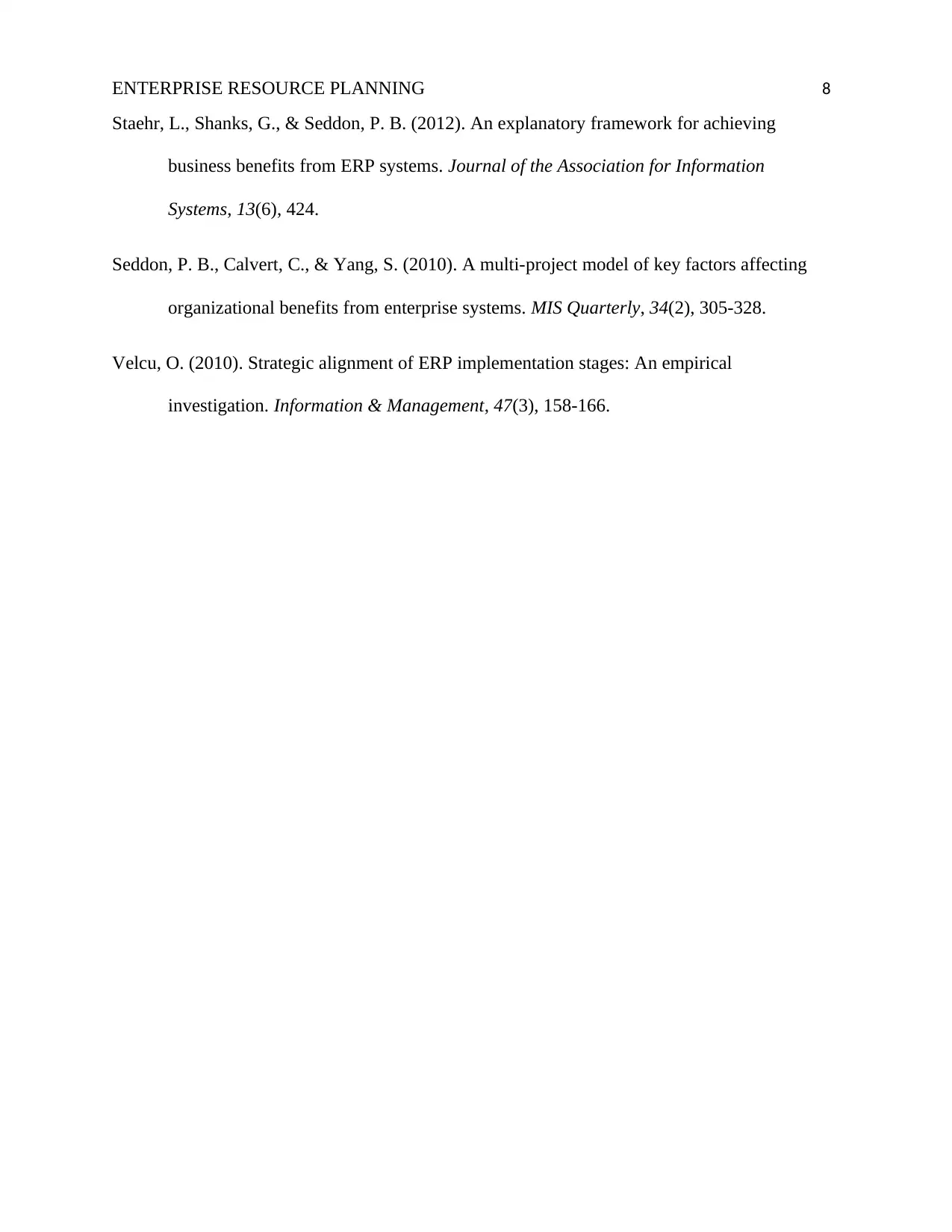
ENTERPRISE RESOURCE PLANNING 8
Staehr, L., Shanks, G., & Seddon, P. B. (2012). An explanatory framework for achieving
business benefits from ERP systems. Journal of the Association for Information
Systems, 13(6), 424.
Seddon, P. B., Calvert, C., & Yang, S. (2010). A multi-project model of key factors affecting
organizational benefits from enterprise systems. MIS Quarterly, 34(2), 305-328.
Velcu, O. (2010). Strategic alignment of ERP implementation stages: An empirical
investigation. Information & Management, 47(3), 158-166.
Staehr, L., Shanks, G., & Seddon, P. B. (2012). An explanatory framework for achieving
business benefits from ERP systems. Journal of the Association for Information
Systems, 13(6), 424.
Seddon, P. B., Calvert, C., & Yang, S. (2010). A multi-project model of key factors affecting
organizational benefits from enterprise systems. MIS Quarterly, 34(2), 305-328.
Velcu, O. (2010). Strategic alignment of ERP implementation stages: An empirical
investigation. Information & Management, 47(3), 158-166.
1 out of 8
Related Documents
Your All-in-One AI-Powered Toolkit for Academic Success.
+13062052269
info@desklib.com
Available 24*7 on WhatsApp / Email
![[object Object]](/_next/static/media/star-bottom.7253800d.svg)
Unlock your academic potential
Copyright © 2020–2025 A2Z Services. All Rights Reserved. Developed and managed by ZUCOL.





